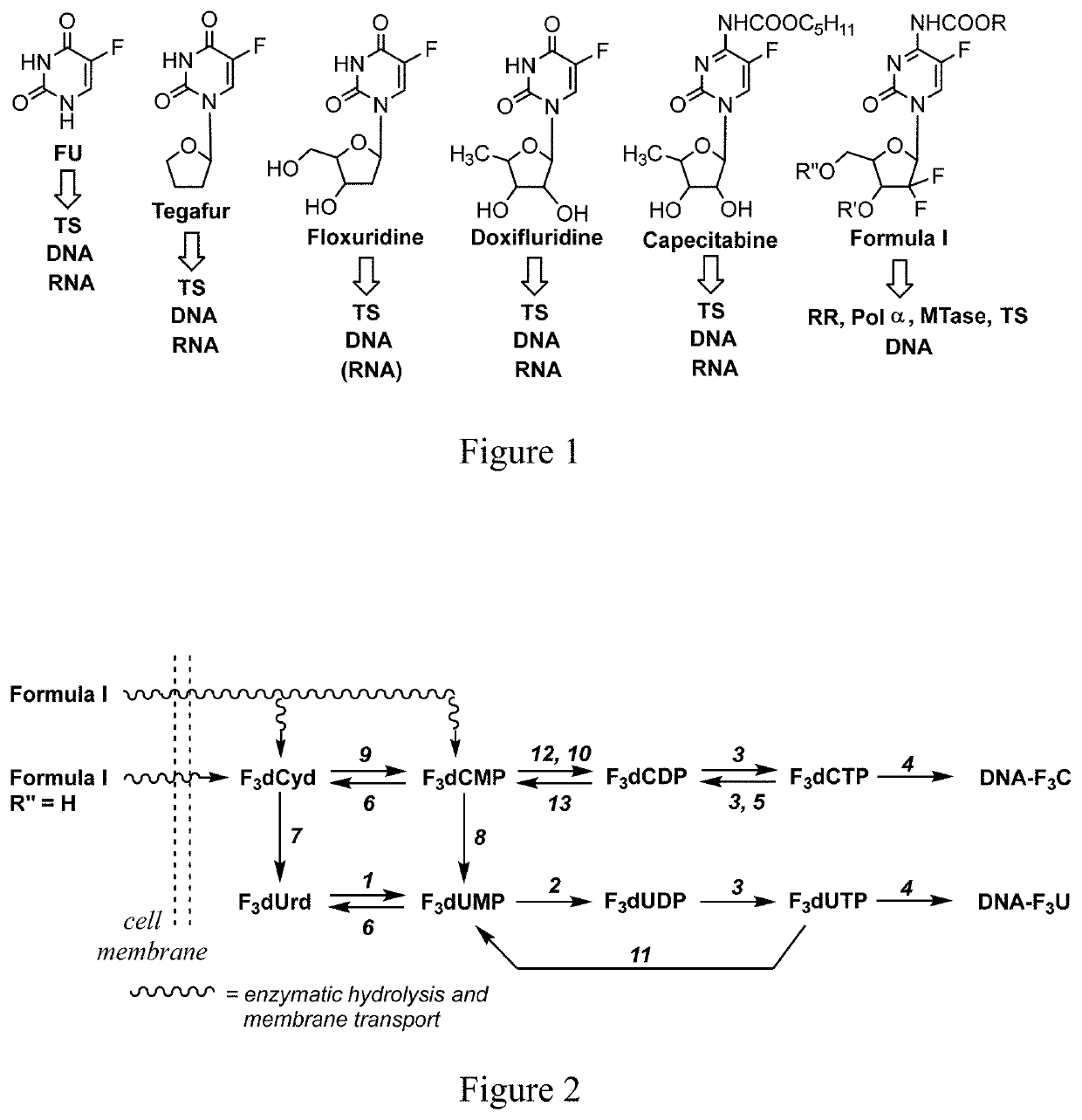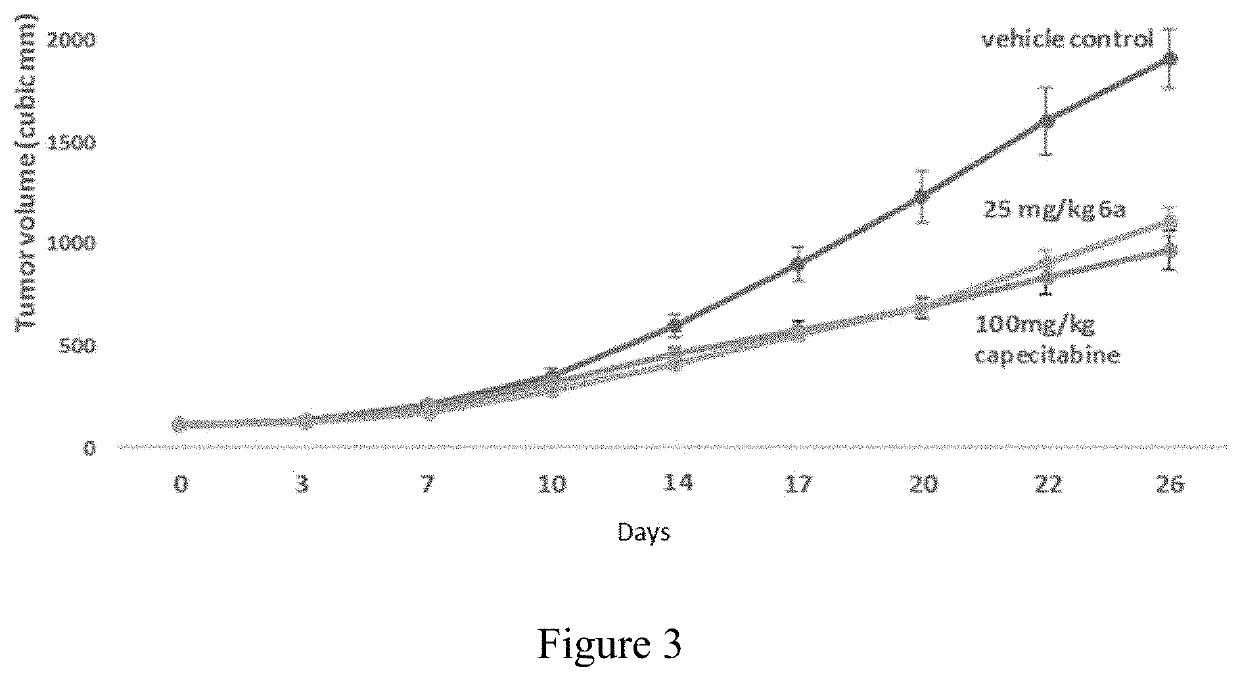Multitargeted nucleoside derivatives
a nucleoside derivative and multi-target technology, applied in the field of nucleoside derivatives, can solve the problems of affecting the survival rate of cancer cells, and affecting the effect of cancer treatment, so as to achieve a greater effect and a favorable effect on all patients
- Summary
- Abstract
- Description
- Claims
- Application Information
AI Technical Summary
Benefits of technology
Problems solved by technology
Method used
Image
Examples
example 1
[0076]This example provides a description of the synthesis of 3′,5′-Di-O-benzoyl-2′-deoxy-2′,2′,5-trifluorocytidine (4).
3′,5′-Di-O-benzoyl-2′-deoxy-2′,2′,5-trifluorocytidine
[0077]5-Fluorocytosine (1, 23.1 g, 178.9 mmol) was treated with hexamethyldisilazane (HMDS, 1,000 mL) in the presence of ammonium sulfate (NH4SO4, 679 mg) under argon and refluxed at 125° C. for 5 hours. The volatiles were removed in vacuo under argon atmosphere to obtain 2 as a white solid. It was dissolved in dry dichloroethane (400 mL) and a solution of 3,5-di-O-benzoyl-2-deoxy-2,2-difluoro-1-O-mathanesulfonyl-α-D-ribofuranoside (3, 32 g, 70.16 mmol), in dry dichloroethane (300 mL) was added to it. The reaction mixture was stirred at room temperature for 10 minutes (min). TMSOTf (38 mL, 210.5 mmol was then added and the mixture was stirred at 95° C. for 16 hours (hrs) under argon. The reaction mixture was cooled to room temperature and then a saturated solution of NaHCO3 was added, followed by stirring for 10 ...
example 2
[0078]This example provides a description of the synthesis of 2′-Deoxy-2′,2′,5-trifluorocytidine (5).
2′-Deoxy-2′,2′,5-trifluorocytidine
[0079]Compound 4 (see Example 1, 33.9 g, 69.3 mmol) was stirred at room temperature with 7N NH4OH in MeOH (190 mL) overnight. The volatiles were evaporated and the residue was partitioned between CH2Cl2 and H2O. The aqueous phase was extracted with CH2Cl2 (3×) then evaporated to dryness. The residue was slurried in i-PrOH (75 mL) and warmed to 60° C., then conc. HCl was added in one portion (15 mL). the thick suspension was cooled to room temperature and white crystals formed immediately, which were filtered off and washed with cold i-PrOH, petroleum ether and Et2O to give compound 5 as 1.5:1.0 mixture of the α / β anomers. The latter was suspended in H2O at 60° C., and then 4N NaOH was added slowly to bring the mixture into solution, then the pH was adjusted to ˜8.3 with 1 N NaOH. A solid precipitated out, which was collected and washed with ice-cold ...
example 3
[0084]This example provides a description of the synthesis of 2′-Deoxy-2′,2′,5-trifluorocytidine hydrochloride (5.HCl).
2′-Deoxy-2′,2′,5-trifluorocytidine hydrochloride
[0085]To a suspension of compound 5 (see Example 2, 5.85 g, 20.8 mmol) was added conc. HCl (5 mL) at 60° C. Upon cooling to room temperature, crystallization occurred. The crystals were filtered, washed with i-PrOH, petroleum ether and Et2O, then dried in vacuo to give 5.HCl as a white solid (5.85 g, 89% from 5): mp 128-135° C.; [α]D=+52.23° (c 0.28, MeOH). LCMS (C-18; 5% isocratic H2O / MeCN): ELSD (peak at 1.08 min), UV (peak at 0.975 min), positive mode: m / z=282 [M+H]+; negative mode: m / z=280 [M−H]−, 316 [M+Cl]−. C9H11F3N3O4Cl (317.20).
[0086]1H NMR (DMSO-d6) δ=3.63 (dd, 1H, H-5′), 3.79 (m, 2H, H-4′, H-5″), 4.18 (m, 1H, H-3′), 5.34 (t, JOH,5′=5.16 Hz, 1H, 5′-OH), 6.06 (t, J1′,F=7.05 Hz, 1H, H-1′), 6.25 (br, 1H, 3′-OH), 7.75, 8.01 (2s, 2H, NH2), 8.04 (d, J6,F=7.17 Hz, 1H, H-6).
[0087]1H HNR (D2O): 8=3.88 (dd, 1H, Jgem=13...
PUM
| Property | Measurement | Unit |
|---|---|---|
| Inhibition | aaaaa | aaaaa |
| Inhibition | aaaaa | aaaaa |
| Inhibition | aaaaa | aaaaa |
Abstract
Description
Claims
Application Information
 Login to View More
Login to View More - R&D Engineer
- R&D Manager
- IP Professional
- Industry Leading Data Capabilities
- Powerful AI technology
- Patent DNA Extraction
Browse by: Latest US Patents, China's latest patents, Technical Efficacy Thesaurus, Application Domain, Technology Topic, Popular Technical Reports.
© 2024 PatSnap. All rights reserved.Legal|Privacy policy|Modern Slavery Act Transparency Statement|Sitemap|About US| Contact US: help@patsnap.com










